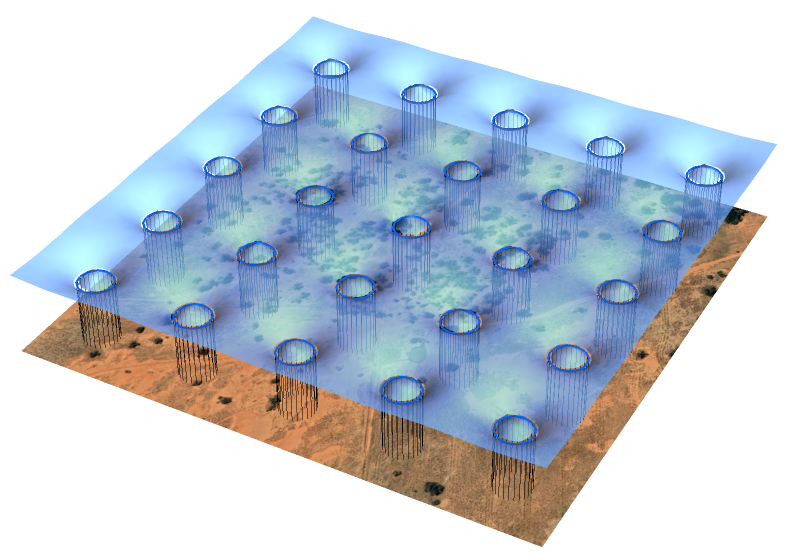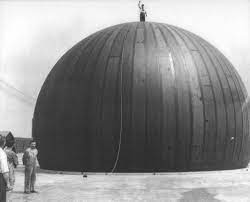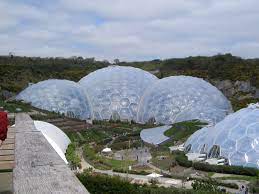Overview
This post proposes a design for a pneumatic structure that creates a container that provides efficient climate control for the volume that it covers. This design is specifically performant at scale.
Initially inspired by designs of human habitats on Mars, I am curious to see if it has commercial viability on Earth. Potential use cases range from agriculture to space exploration.
The core advantage of pneumatic structures is that they are lightweight, cheap, and easy to deploy per unit of space enclosed versus alternatives.
Motivation
Climate Change
As climate change produces more extreme weather patterns and more extreme natural disasters, the places where humans grow food and live are under threat.
Agriculture:
- Increased weather volatility threatens growing seasons as early frosts or late rains can destroy harvests, leading to food insecurity.
- Inefficient use of arable land due to longer growing seasons in otherwise resource-constrained areas.
- Decrease in arable land due to too hot or too cold weather patterns.
Habitability:
- Extreme heat and wet bulb temperatures make it dangerous to go outside in more places during the summer.
- Extreme cold makes it dangerous to go outside in more places during the winter.
Abundance
Even if climate change were not an issue, being able to control large volumes of area is an awesome future. Imagine bringing the weather of San Diego, California, during the summer to Cheyenne, Wyoming, during the winter.
A plurality of the exodus from T1 cities during Covid fled to the South and Sunbelt. Cold cities, even with good urbanism, business-friendly laws, and affordable housing, struggle to attract talent because people hate living in long, cold winters. Large-scale climate control offers a solution.
Beyond human habitats on Earth, there are other potential use cases for pneumatic structures:
- Mars/Lunar colonization
- The original inspiration: https://caseyhandmer.wordpress.com/2019/11/28/domes-are-very-over-rated/.
- Reducing Resource shortage
- Increasing the amount of habitable and arable land.
- Creating pollution-free spaces in Asian cities.
- Cheap, ISS-type space centers.
- https://en.wikipedia.org/wiki/Inflatable_space_habitat#:~:text=Inflatable habitats or expandable habitats, internal volume increases after launch.
Solution
Thoughts and numbers here are heavily influenced by Nick Parker and his work here: https://nickparker.co/exciting/inflatable-structures
Base Implementation
Mass-scale climate control over areas where people grow food and work with polymer pneumatic structures, what we call inflatable canopies.
Inflatable canopies generally:
- Constructed with polymer membranes and rigid base “wall.”
- Hold their structure with air pressure and tension cables.
- Are cheap to manufacture, deploy, and adjust.
- Leverage natural phenomena like radiative cooling and greenhouse effects to control temperature with minimal energy expenditures.
The initial design for inflatable canopies will have four base constituents:
- ETFE membrane
- Access walls
- Steel tension cables
- Air pumps
Access walls surround the canopy and provide rigidity to install doors and vents for access and climate control. ETFE membrane attaches to the rims of the access walls. Air pumps maintain pressure inside, making the ETFE membrane taut. Steel tension cables attach from the roof of the canopy to the floor to distribute tension and provide a flat structure that scales the canopy linearly with area. This is in contrast with domes where material scales cubically with land covered.
ETFE, specifically, is incredibly transparent, often used as a glass replacement, and is utilized to leverage greenhouse effects in enabling energy-efficient climate control. The opposite effect using radiative cooling may need other materials, like HDPE.
Casey Handmer has a visualization of what this may look like on Mars:

History and Present-Day
Pneumatic structures were initially commissioned by the military in 1946 to provide covers to radars to prevent them from getting destroyed by bad weather. The first implementation was something called a Radome [Radio Dome], which you can see here:

The technology immediately captured the minds of technologists in the mid-20th century, who came up with bold designs for temperature-controlling domes across the Arctic, Manhattan, Calgary, Houston, and many more places. Here are some examples:


Today, while not a pneumatic structure, the idea of climate controlling massive regions of land lives on. Check out Poniente Almeriense, sometimes called the Sea of Plastic, in the South of Spain. Settlers turned an arid, southern province into a massive farm supplying a non-trivial amount of food to the rest of Europe. Today, it covers 100k acres [3x the size of SF] and is home to 259k people!

Why Now
Three key factors make today the right time to think about large inflatable structures for residential, agricultural, and commercial purposes:
- Climate change is turning this from a luxury to a necessity.
- Improvements in polymer synthesis and manufacturing have created cheap, lightweight, and high-performance materials [ETFE].
- Cheap, renewable energy makes maintaining air pressure over large areas economical.
It's slowly beginning to happen. Eden Project was the first to use advancements in technology to create large biodomes.

Today, the problem is a design problem, not a technology problem.
Ask
The biggest open question is commercialization. How do you take this to market? Is this an important problem to solve? What are some value-added services you could add? What are the initial high-value use cases this could help in? Who are the right people to talk to?
My intuition is industrial and agricultural projects before residential. However, I can’t help but feel most excited about the residential use cases. More competition for talent between states!
What do you guys think?
Inspirations
https://caseyhandmer.wordpress.com/2019/11/28/domes-are-very-over-rated/
